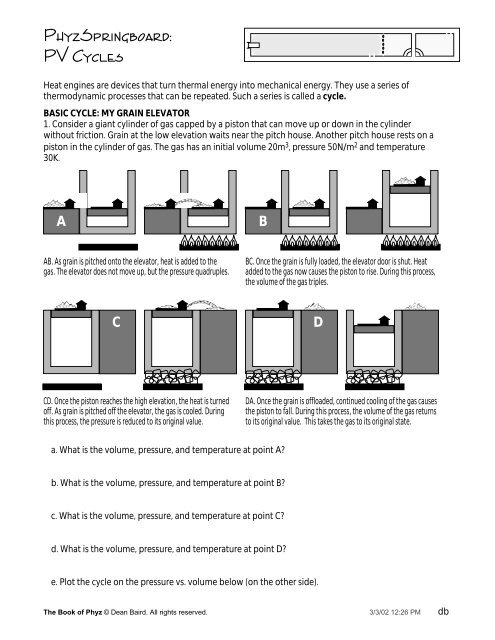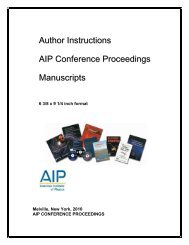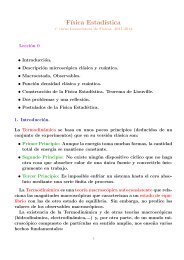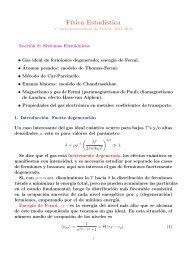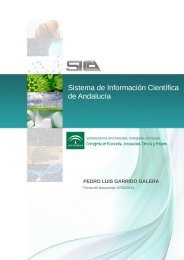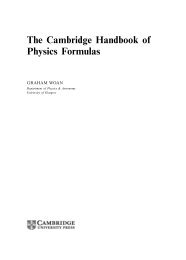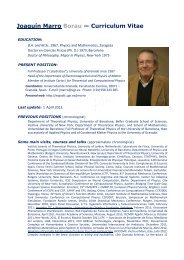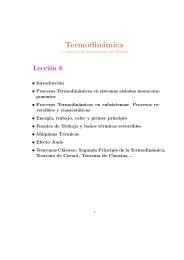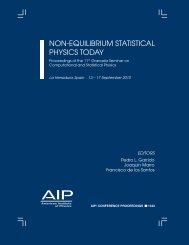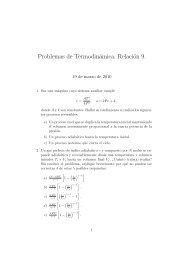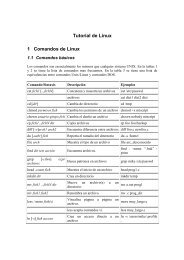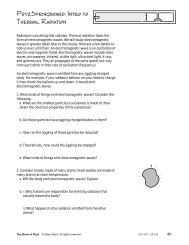Create successful ePaper yourself
Turn your PDF publications into a flip-book with our unique Google optimized e-Paper software.
<strong>PhyzSpringboard</strong>:<br />
<strong>PV</strong> <strong>Cycles</strong><br />
Heat engines are devices that turn thermal energy into mechanical energy. They use a series of<br />
thermodynamic processes that can be repeated. Such a series is called a cycle.<br />
BASIC CYCLE: MY GRAIN ELEVATOR<br />
1. Consider a giant cylinder of gas capped by a piston that can move up or down in the cylinder<br />
without friction. Grain at the low elevation waits near the pitch house. Another pitch house rests on a<br />
piston in the cylinder of gas. The gas has an initial volume 20m 3 , pressure 50N/m 2 and temperature<br />
30K.<br />
A B<br />
AB. As grain is pitched onto the elevator, heat is added to the<br />
gas. The elevator does not move up, but the pressure quadruples.<br />
C D<br />
CD. Once the piston reaches the high elevation, the heat is turned<br />
off. As grain is pitched off the elevator, the gas is cooled. During<br />
this process, the pressure is reduced to its original value.<br />
a. What is the volume, pressure, and temperature at point A?<br />
b. What is the volume, pressure, and temperature at point B?<br />
c. What is the volume, pressure, and temperature at point C?<br />
d. What is the volume, pressure, and temperature at point D?<br />
e. Plot the cycle on the pressure vs. volume below (on the other side).<br />
BC. Once the grain is fully loaded, the elevator door is shut. Heat<br />
added to the gas now causes the piston to rise. During this process,<br />
the volume of the gas triples.<br />
DA. Once the grain is offloaded, continued cooling of the gas causes<br />
the piston to fall. During this process, the volume of the gas returns<br />
to its original value. This takes the gas to its original state.<br />
The Book of Phyz © Dean Baird. All rights reserved. 3/3/02 12:26 PM<br />
db
P (N/m 2 )<br />
f. How much work was done ON the gas during each process?<br />
i. AB<br />
ii. BC<br />
iii. CD<br />
iv. DA<br />
v. What was the net work done ON the gas? (This is the work in, W in .)<br />
g. The molar specific heat capacities of the gas are C v = (3/2)R and C p = (5/2)R. How much heat was<br />
added or removed in each process?<br />
i. AB<br />
ii. BC<br />
iii. CD<br />
iv. DA<br />
250<br />
200<br />
150<br />
100<br />
50<br />
20<br />
40<br />
V (m3 )<br />
The Book of Phyz © Dean Baird. All rights reserved. db<br />
60<br />
80
v. What was the total heat added from A to C? (This is the heat in, Q in , and heat added, Q H .)<br />
vi. What was the total heat ejected from C to A? (Heat ejected, Q C or Q L , will be a positive value.)<br />
vii. More heat was added than was ejected during the cycle. Account for the difference (explain<br />
what happened to the heat that was added but never ejected).<br />
h. What was the efficiency of the cycle? Show two calculations.<br />
A MORE EFFICIENT CYCLE: THE CARNOT ENGINE<br />
2. Consider a cylinder of gas going through the following cycle. The initial conditions are: P =<br />
240N/m 2 , V = 20m 3 , and T = 360K.<br />
A AB<br />
B<br />
AB. As the story begins, the piston is rising. It had a "head start,"<br />
in the sense that it was already moving up before we saw it. But<br />
6545J heat is added nonetheless to keep it motivated. Since the<br />
gas is expanding upward faster than the added heat would force<br />
it to, the pressure is dropping. It drops to half its original value<br />
while the volume doubles. The temperature remains constant.<br />
C CD<br />
D<br />
CD. Heat is removed. The gas contracts to half its previous<br />
volume. The pressure increases to double its previous value. The<br />
temperature remains constant.<br />
BC. The heat is turned off, but the piston continues to rise and<br />
the pressure continues to drop. The pressure falls to 1/30th its<br />
original value as the volume increases to 2.5 times its original<br />
value.<br />
DA. No heat is added or removed. The gas continues to contract<br />
and the pressure rises. The temperature increases. When all is<br />
done, the gas has returned to its original state.<br />
The Book of Phyz © Dean Baird. All rights reserved. db<br />
BC<br />
DA<br />
C<br />
A
a. Determine the volume, pressure, and temperature at points B, C, and D. Plot the cycle on the axes<br />
below. Identify points A-D and label the temperatures of the isotherms.<br />
P (N/m 2 )<br />
240<br />
200<br />
160<br />
120<br />
80<br />
40<br />
b. What is the Carnot efficiency of this engine?<br />
c. How much work was done from A to B?<br />
d. How much heat is ejected from C to D?<br />
10 20<br />
30<br />
V (m<br />
40<br />
50<br />
3 )<br />
e. What was the net work done by the engine during one cycle?<br />
The Book of Phyz © Dean Baird. All rights reserved. db


